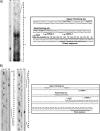Control of flagellar gene regulation in Legionella pneumophila and its relation to growth phase
- PMID: 19915024
- PMCID: PMC2805308
- DOI: 10.1128/JB.00610-09
Control of flagellar gene regulation in Legionella pneumophila and its relation to growth phase
Abstract
The bacterial pathogen Legionella pneumophila responds to environmental changes by differentiation. At least two forms are well described: replicative bacteria are avirulent; in contrast, transmissive bacteria express virulence traits and flagella. Phenotypic analysis, Western blotting, and electron microscopy of mutants of the regulatory genes encoding RpoN, FleQ, FleR, and FliA demonstrated that flagellin expression is strongly repressed and that the mutants are nonflagellated in the transmissive phase. Transcriptome analyses elucidated that RpoN, together with FleQ, enhances transcription of 14 out of 31 flagellar class II genes, which code for the basal body, hook, and regulatory proteins. Unexpectedly, FleQ independent of RpoN enhances the transcription of fliA encoding sigma 28. Expression analysis of a fliA mutant showed that FliA activates three out of the five remaining flagellar class III genes and the flagellar class IV genes. Surprisingly, FleR does not induce but inhibits expression of at least 14 flagellar class III genes on the transcriptional level. Thus, we propose that flagellar class II genes are controlled by FleQ and RpoN, whereas the transcription of the class III gene fliA is controlled in a FleQ-dependent but RpoN-independent manner. However, RpoN and FleR might influence flagellin synthesis on a posttranscriptional level. In contrast to the commonly accepted view that enhancer-binding proteins such as FleQ always interact with RpoN to fullfill their regulatory functions, our results strongly indicate that FleQ regulates gene expression that is RpoN dependent and RpoN independent. Finally, FliA induces expression of flagellar class III and IV genes leading to the complete synthesis of the flagellum.
Figures




References
-
- Bradford, M. M. 1976. A rapid and sensitive method for the quantitation of microgram quantities of protein utilizing the principle of protein-dye binding. Anal. Biochem. 72:248-254. - PubMed
-
- Brüggemann, H., A. Hagman, M. Jules, O. Sismeiro, M. Dillies, C. Gouyette, F. Kunst, M. Steinert, K. Heuner, J. Coppée, and C. Buchrieser. 2006. Virulence strategies for infecting phagocytes deduced from the in vivo transcriptional program of Legionella pneumophila. Cell. Microbiol. 8:1228-1240. - PubMed
-
- Cazalet, C., C. Rusniok, H. Bruggemann, N. Zidane, A. Magnier, L. Ma, M. Tichit, S. Jarraud, C. Bouchier, F. Vandenesch, F. Kunst, J. Etienne, P. Glaser, and C. Buchrieser. 2004. Evidence in the Legionella pneumophila genome for exploitation of host cell functions and high genome plasticity. Nat. Genet. 36:1165-1173. - PubMed
Publication types
MeSH terms
Substances
Grants and funding
LinkOut - more resources
Full Text Sources
Molecular Biology Databases

